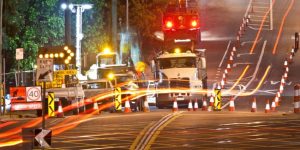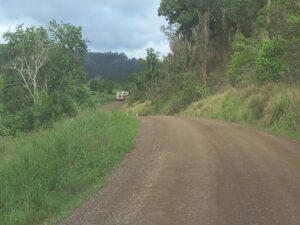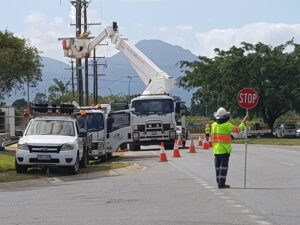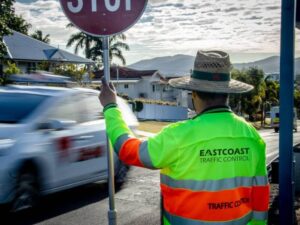Traffic control is often associated with roadworks, construction sites, and highway maintenance. However, its role extends far beyond these areas. Traffic management plays a crucial part in ensuring safety, efficiency, and order at public events, large gatherings, and celebrations. Whether it’s a music festival, a sporting event, or a major parade, traffic control teams are vital to managing crowds, directing vehicles, and minimising disruptions. This blog explores how traffic control supports public events and large gatherings, highlighting the importance of planning, safety measures, and strategic management to keep everything running smoothly.
The Essential Role of Traffic Control at Public Events
Public events attract large numbers of people, often resulting in increased vehicular and pedestrian traffic. Managing this influx is crucial to ensuring the safety of attendees and minimising the risk of accidents. Traffic control teams play an essential role in directing vehicles, guiding pedestrians, and setting up road closures to manage crowd flow effectively. Their work ensures that everyone can enjoy the event safely while also minimising disruptions to the local area.
Planning and Preparation: The Foundation of Safe Event Traffic Management
Successful traffic management for events starts long before the first attendee arrives. It begins with detailed planning and preparation. Traffic control companies collaborate with event organisers, local councils, law enforcement, and emergency services to develop comprehensive traffic management plans (TMPs). These plans consider various factors, including event location, expected crowd size, road closures, parking arrangements, and emergency access routes.
Strategic planning is particularly important for events that take place in busy urban areas, where road closures or changes to traffic flow can significantly impact daily life. For example, events in central locations such as Brisbane’s South Bank or Sydney’s Circular Quay require meticulous planning to balance the needs of the event with those of the community and businesses in the area.
Ensuring Pedestrian Safety
Large gatherings such as parades and festivals attract a significant number of pedestrians. Effective traffic control ensures that these pedestrians can move safely around the event site. This may involve setting up temporary pedestrian crossings, barricading areas, and guiding foot traffic away from vehicle routes. In addition to directing the flow of people, traffic controllers are trained to respond to unexpected situations, such as medical emergencies, ensuring that crowds are managed calmly and safely.
Managing Parking and Vehicle Access
One of the key challenges of large events is managing parking and vehicle access. Without proper planning, event-related traffic can lead to congestion, frustration, and safety risks. Traffic control teams are responsible for directing vehicles to designated parking areas, implementing traffic diversions, and monitoring entry and exit points to keep everything moving smoothly. For events held in stadiums, racecourses, or concert venues, managing traffic around the site is essential to prevent gridlock and ensure that emergency services can access the area if needed.
Temporary Road Closures and Detours
Road closures and detours are often necessary to facilitate large gatherings or public events. Traffic control teams play a critical role in setting up temporary road closures, installing signage, and establishing detour routes to minimise the impact on local traffic. Temporary road closures help ensure that the event space remains safe for attendees while also preventing vehicles from entering crowded pedestrian areas. Clear signage and well-planned detour routes ensure that road users are kept informed and can navigate alternative routes with minimal disruption.
Adapting to Different Event Types: From Parades to Festivals
Not all events are created equal, and traffic control requirements can vary significantly depending on the type of event. For example, managing traffic for a large music festival held in a rural area may involve setting up temporary roads and parking areas in fields, whereas a city marathon will require extensive road closures and diversions in an urban setting. Traffic control teams need to adapt their strategies to suit the specific needs of each event.
At parades, for instance, controlling the movement of floats and performers is essential, while ensuring spectators remain at a safe distance from the parade route. In contrast, sporting events may require traffic management not only at the event site but also in the surrounding streets, where increased traffic can cause congestion.
Real-Time Traffic Management: Handling the Unexpected
Even with detailed planning, unexpected situations can arise during events. Real-time traffic management is crucial to adapting to changes quickly and efficiently. Traffic control teams use communication tools and monitoring systems to stay updated on the situation and adjust traffic flow as needed. This may involve redirecting traffic to avoid congestion, altering pedestrian routes, or coordinating with emergency services to address incidents.
Effective real-time management helps to minimise disruptions, ensure safety, and keep the event running smoothly.
The Importance of Communication and Coordination
Communication is a cornerstone of successful traffic management at public events. Traffic controllers need to communicate effectively with event organisers, local authorities, emergency services, and the public. This involves using clear signage, public announcements, and on-site staff to keep everyone informed of road closures, detours, and any other changes.
Coordination with emergency services is especially important, as traffic control teams must ensure that emergency vehicles can access the event site quickly if required. Working closely with law enforcement and other agencies helps traffic control teams respond promptly to any safety concerns, enhancing overall event security.
Leveraging Technology for Better Traffic Management
Modern traffic control for public events goes beyond physical barriers and stop signs. It often involves the use of technology to monitor and manage traffic flow. Traffic control companies may use digital signage, portable traffic lights, and real-time traffic monitoring systems to improve efficiency and adaptability. GPS tracking and communication tools allow traffic control teams to make real-time adjustments based on traffic conditions, ensuring a safer and smoother experience for all.
Supporting Local Communities During Events
Traffic management for public events extends beyond attendee safety; it also involves supporting the local community. Well-planned traffic control helps minimise disruptions for local residents and businesses by clearly communicating road closures, providing adequate detours, and ensuring that access to essential services is maintained. This approach fosters positive relationships with the community and helps maintain public support for future events.
The Role of Traffic Control in Post-Event Cleanup
The job of a traffic control team doesn’t end when the event finishes. Post-event cleanup is a crucial part of the process, as it ensures that roads are reopened safely and efficiently. This may involve removing temporary signage, dismantling barriers, and guiding vehicles and pedestrians away from the event site. Effective post-event traffic management helps to restore normal traffic flow and reduce the impact of the event on local communities.
Final Word
Traffic control is a vital component of managing large public events and gatherings. Its role goes far beyond roadworks and construction sites, encompassing a range of tasks, including pedestrian safety, vehicle access, road closures, and real-time traffic management. By ensuring the safety and efficiency of events, traffic control teams play an indispensable role in making public gatherings enjoyable and safe for everyone.
FAQs
- Why is traffic control important for public events?
Traffic control ensures the safety of attendees, manages vehicle and pedestrian flow, and minimises disruptions to the local area. - How does traffic management differ for various types of events?
Different events, such as festivals, parades, or sporting events, have unique traffic control needs, requiring customised management plans. - What role does technology play in modern traffic control for events?
Technology, such as digital signage and real-time monitoring, helps traffic control teams respond quickly and manage traffic more effectively. - Why are temporary road closures necessary during events?
Road closures help maintain the safety of event attendees by preventing vehicles from entering crowded areas. - How do traffic control teams support the local community during events?
They minimise disruptions by coordinating road closures, providing detours, and maintaining access to essential services.





